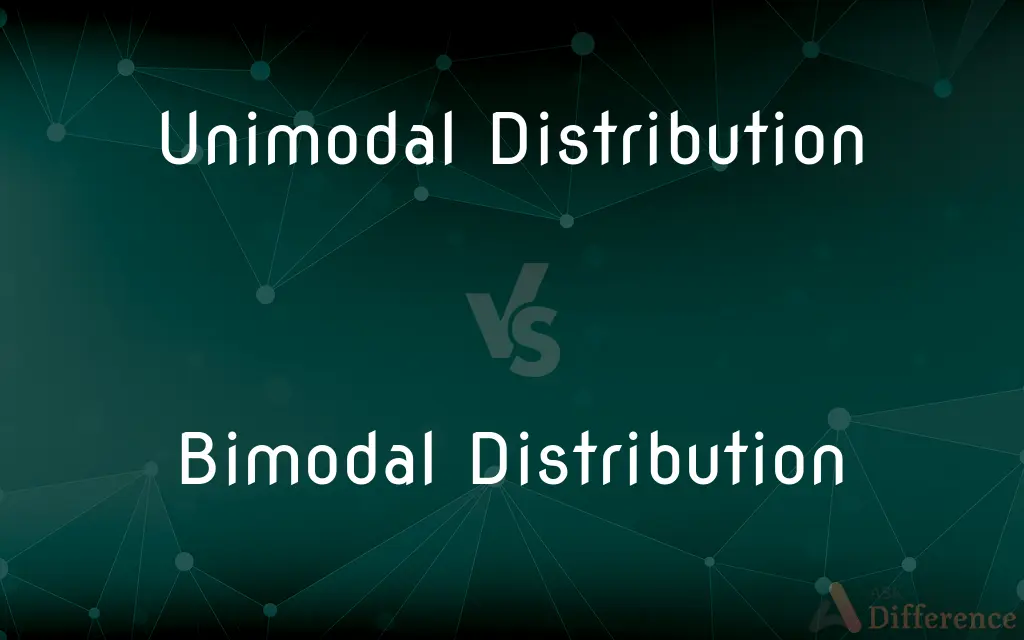Unimodal Distribution vs. Bimodal Distribution — What's the Difference?
By Tayyaba Rehman — Published on January 31, 2024
A unimodal distribution has one distinct peak or mode, indicating a single dominant data cluster, whereas a bimodal distribution has two distinct peaks, indicating two dominant data clusters.

Difference Between Unimodal Distribution and Bimodal Distribution
Table of Contents
ADVERTISEMENT
Key Differences
A unimodal distribution in statistics represents a dataset that has a single, clear peak or mode in its frequency distribution. This peak indicates the most common value or range of values in the dataset. In contrast, a bimodal distribution has two distinct peaks, each representing a different mode or central value in the data, suggesting the presence of two prominent groups or clusters within the dataset.
Unimodal distributions are often seen in datasets where one outcome or group is more dominant or common than others. This single peak can be central (symmetric distribution) or off-centered (skewed distribution). Bimodal distributions, however, imply a more complex dataset where two different outcomes or groups are equally or nearly equally dominant, resulting in two separate peaks in the distribution curve.
In terms of interpretation, unimodal distributions suggest a certain uniformity or consistency in the data, with most values clustering around a single central point. Bimodal distributions indicate diversity or bifurcation in the dataset, with values clustering around two different points, which can be significant in identifying subgroups or dual trends in the data.
Examples of unimodal distributions include scenarios like the heights of adult men in a region (assuming one dominant height group) or test scores in a class (if most students score around the same range). Bimodal distributions could be observed in scenarios like the heights of a mixed group of men and women (two distinct height groups) or the ratings of a polarizing movie (where audiences are split into two distinct opinion groups).
Analyzing a unimodal distribution typically involves examining the central tendency, variability, and skewness around the single peak. In a bimodal distribution, analysis might focus on understanding the characteristics of each peak, the distance between them, and the distribution of data within and around these peaks, to glean insights into the dual nature of the dataset.
ADVERTISEMENT
Comparison Chart
Number of Peaks
One distinct peak
Two distinct peaks
Interpretation
Indicates a single dominant group/trend
Indicates two dominant groups/trends
Commonality of Data
Data clusters around a single point
Data clusters around two separate points
Complexity
Generally simpler and more uniform
More complex, indicating diversity
Analysis Focus
Central tendency, variability, skewness
Characteristics and separation of peaks
Compare with Definitions
Unimodal Distribution
A distribution with one peak or mode.
The unimodal distribution of exam scores showed most students scored around 75%.
Bimodal Distribution
A distribution with two distinct peaks or modes.
The bimodal distribution of a survey showed two popular choices among respondents.
Unimodal Distribution
Represents a dataset clustering around a single value.
Height measurements of adult men in a small town formed a unimodal distribution.
Bimodal Distribution
Represents dual trends or clusters in data.
Customer age groups for a product showed a bimodal distribution with peaks at 20 and 50 years.
Unimodal Distribution
Shows uniformity or consistency in data.
Income levels in a specific neighborhood displayed a unimodal distribution.
Bimodal Distribution
A statistical distribution with two separate peaks.
The bimodal distribution of daily internet usage peaked in the morning and evening.
Unimodal Distribution
Indicates a single predominant group in data.
The unimodal distribution of a product's customer age group centered around 30-40 years.
Bimodal Distribution
Shows diversity or bifurcation in data.
The movie ratings formed a bimodal distribution, indicating polarized opinions.
Unimodal Distribution
A statistical distribution with one central peak.
The unimodal distribution of temperatures in July peaks at 85°F.
Bimodal Distribution
Indicates two dominant groups in a dataset.
The heights of adults in a city showed a bimodal distribution, reflecting men and women.
Common Curiosities
Can a unimodal distribution be skewed?
Yes, a unimodal distribution can be symmetric or skewed.
What can a bimodal distribution suggest in data analysis?
It suggests the presence of two distinct groups or trends in the dataset.
How does a bimodal distribution differ?
A bimodal distribution has two distinct peaks, indicating two central values or trends.
What is a unimodal distribution?
It's a statistical distribution with one distinct peak or mode.
Are unimodal distributions common in nature?
Yes, many natural phenomena exhibit unimodal distributions.
Can a dataset be both unimodal and bimodal?
No, a dataset is either unimodal or bimodal based on the number of peaks.
What are examples of unimodal distributions in real life?
Heights of people in a specific group or test scores in a class.
What could cause a bimodal distribution?
Diverse or dual factors influencing the dataset can lead to a bimodal distribution.
What does each peak in a bimodal distribution represent?
Each peak represents a dominant group or trend within the dataset.
How do you identify a unimodal distribution?
By finding a single, most frequent value or range of values in the data.
Can a bimodal distribution merge into a unimodal distribution?
Yes, under certain conditions, like changes in the dataset or measurement criteria.
Is the analysis of bimodal distributions more complex?
Generally, yes, due to the need to understand the dual nature of the data.
What's an example of a bimodal distribution in everyday life?
Heights in a mixed-gender group or opinions on a divisive topic.
Does a unimodal distribution imply homogeneity?
It often suggests a degree of uniformity, but not necessarily homogeneity.
What statistical measures are used for unimodal distributions?
Measures like mean, median, mode, variance, and skewness are commonly used.
Share Your Discovery

Previous Comparison
BDrip vs. BRrip
Next Comparison
Edamame vs. SoybeansAuthor Spotlight
Written by
Tayyaba RehmanTayyaba Rehman is a distinguished writer, currently serving as a primary contributor to askdifference.com. As a researcher in semantics and etymology, Tayyaba's passion for the complexity of languages and their distinctions has found a perfect home on the platform. Tayyaba delves into the intricacies of language, distinguishing between commonly confused words and phrases, thereby providing clarity for readers worldwide.
















































